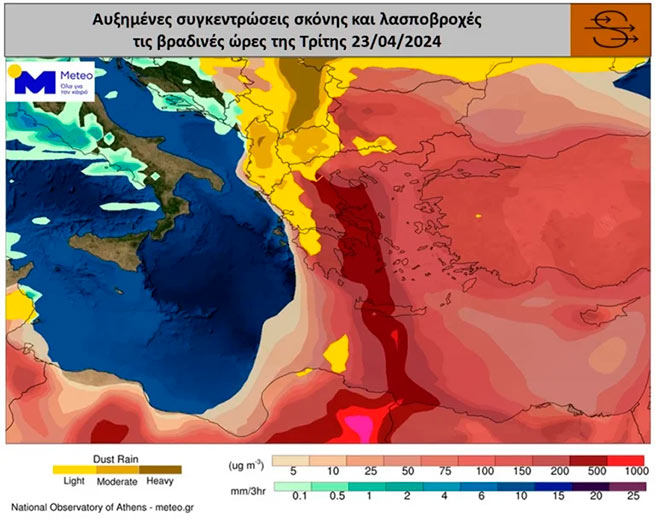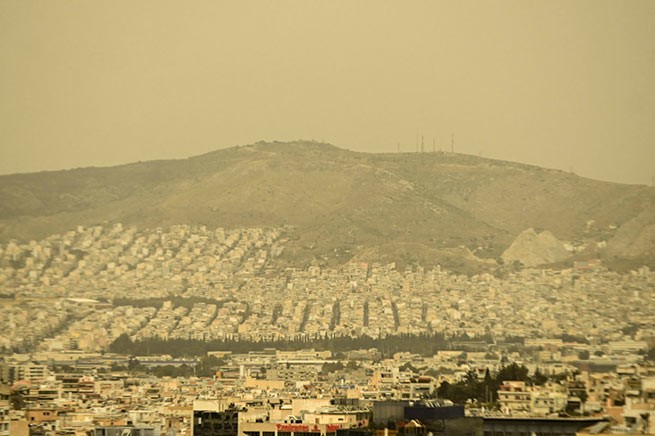The atmosphere in Attica has been suffocating since the morning due to the African dust that has “covered” the capital of Greece. The photographs highlight the situation in the pool.
According to the forecast from meteo.gr/Athens National Observatory, in addition to very high dust concentrations that will limit visibility, there will be mud showers in the metropolitan area.

Saharan dust levels are expected to peak in Greece on April 23. See photos:
View the embedded image gallery online at:
https://rua.gr/news/prireco/62568-afrikanskaya-pyl-udushayushchaya-atmosfera-v-attike.html#sigProId8efbda40ae
African dust: expert recommendations
People with pre-existing respiratory conditions are particularly vulnerable during periods of elevated dust levels, which is reflected in increased hospital admissions.
African dust is a relatively common phenomenon in Greece, especially when meteorological conditions favor the transport of dust particles from the Sahara Desert. The frequency and intensity of African dust in Greece can vary from year to year, from 7 to 20 episodes (average 13 episodes/year), depending on atmospheric conditions and the amount of dust transported from the Sahara. In general, African dust is not uncommon in the Greek region.
This natural phenomenon can have a significant impact on the health of our country's residents, mainly due to deteriorating air quality. African dust carries a wide range of particle sizes, such as PM10, PM2.5 or even much smaller, and can also pick up pollutants from the atmosphere. Increasing amounts of particles in the atmosphere can worsen respiratory diseases such as asthma, bronchitis and allergies.
Residents of urban centers and areas with poor air quality require special attention.
Effects on the respiratory system
One of the main health effects of African dust is its effect on the respiratory system. Fine dust particles can penetrate deep into the lungs and even enter the bloodstream. For people with conditions such as asthma, bronchitis or chronic obstructive pulmonary disease (COPD), exposure to these particles can worsen symptoms, leading to shortness of breath, cough, wheezing and chest discomfort.

Use masks
Allergies and irritation
African dust can cause allergic reactions, respiratory irritation, nasal congestion, sneezing and watery eyes in some people. People with allergies or environmental sensitivities may experience increased symptoms during periods of high levels of African dust.
Cardiovascular problems
In addition to breathing problems, exposure to African dust is associated with cardiovascular problems. Particulate matter can promote inflammation, oxidative stress and vasoconstriction, which increases the risk of heart attacks, strokes and other cardiovascular diseases, especially in vulnerable populations.
Effect on the immune system. Long-term exposure to African dust can also affect the immune system, making people more susceptible to respiratory infections and other illnesses. The inflammatory response caused by dust particles can weaken the body's defenses and make it more difficult to fight pathogens.
Long-term health risks
Chronic exposure to African dust and related pollutants is associated with long-term health risks, including respiratory disease, decreased lung function, cardiovascular problems and even some types of cancer. Chronic exposure to high levels of particulate matter can have cumulative health effects over time.
According to a 2020 review of the impact of dust on air quality in Europe, approximately 42,000 deaths per year are attributed to dust, and in Mediterranean countries an estimated 27-44% of deaths associated with PM10 particles are due to African dust.
It is important that people, especially those with respiratory conditions, take precautions during periods of elevated levels of African dust. Here are some tips to help you minimize the health consequences of this phenomenon:
Stay up to date
Monitor air quality reports and weather forecasts to know when high African dust levels are expected. If possible, avoid prolonged exposure to high dust levels outdoors, especially on windy days when particles are more likely to be suspended.
Close the windows and doors
Although homes and workplaces should generally be ventilated, during periods of African dust outbreaks, ventilate a little in the morning and then keep windows and doors closed to prevent dust particles from entering the home or workplace. If you have one, use air purifiers or filters to improve indoor air quality.
Use masks
When you go outside, especially in dusty weather, wear a mask to reduce the risk of inhaling dust particles.
Stay hydrated. Drink plenty of water
During periods of high dust levels, people with pre-existing respiratory conditions are strongly advised to take precautions to minimize the health effects of exposure to dust particles. For patients with asthma You may need to increase the dosage or frequency of inhaled medications according to the monitoring plan recommended by your doctor to reduce symptoms. It should be noted that at this stage it is recommended to pay special attention to asthmatics in connection with spring allergies. Patients with chronic obstructive pulmonary disease may require increased palliative treatment with inhaled medications.








More Stories
Weather: hot and windy weekend
Blue Flag: 22 Greek beaches stripped of honorary label
What Are Cruise Ships Worth for the Planet (Video)